Requirements for air humidity in the catering unit: norms and rules for arranging ventilation in the catering unit
Rospotrebnadzor has developed strict standards and requirements for air humidity in the catering of food service outlets. Indeed, you must admit that a comfortable microclimate has a positive effect and contributes to the efficient work of bakers and culinary specialists, and provides a good appetite for visitors. The rules are quite strict and clearly range the limits of acceptable values.
Violation of them can provoke a deterioration in the health of the staff of the catering department, create an ideal environment for the rapid growth and reproduction of microbes and pathogenic bacteria.
In this article, we will consider the basic requirements of Rospotrebnadzor to the humidity of all rooms of the catering unit, introduce you to control and accounting methods.
The content of the article:
What is a catering unit?
Speaking of the catering unit, many imagine a room in which to cook food and undergo heat treatment products. But this is not entirely true.
First of all, it is worth knowing that a catering unit is not only a kitchen and dining rooms, but also other rooms directly or indirectly related to the organization of public catering.
The catering complex includes:
- washing;
- kitchens;
- linen, food warehouses;
- cold rooms;
- dressing rooms, etc.
Cabinets and various administrative premises also include a catering unit.
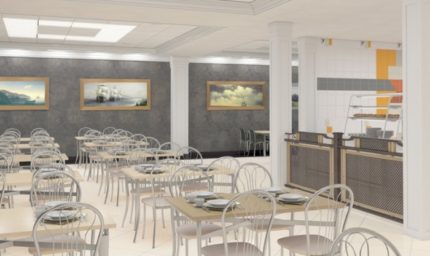
Most of the premises of the catering unit are equipped with equipment that during operation has a direct effect on temperature and humidity.
Humidity level in the catering unit
In each room of the catering unit, the optimum air temperature and humidity should be maintained, taking into account the equipment used. For example, in hot workshops, constantly operating electrical systems have a large effect on humidity. gas stoves.
During operation, not only they themselves are heated, the temperature of the working surfaces increases, the air dries out quite strongly.
This can adversely affect the health of workers in these workshops, since dry air dries out the mucous membranes and contains very little oxygen.
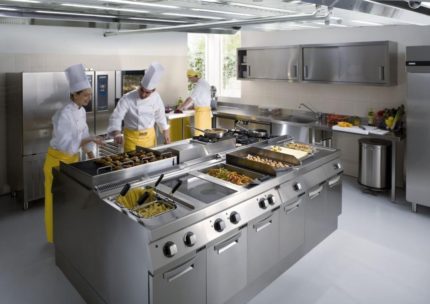
The strongest influence on the microclimate of the catering unit is:
- continuous cooking cycle, its heat treatment;
- drying;
- washing;
- pipes and radiators in the cold season.
The negative impact of equipment is usually offset by the installation of local exhaust systems and supply ventilation.
Sanitary requirements for humidity
Sanitary rules 2.3.6.1079-01 "Sanitary and epidemiological requirements for public catering organizations, the manufacture and turnover of food products and food raw materials in them", SanPiN 2.2.4.548-96 “Hygienic requirements for the microclimate of industrial premises” make it clear that the optimum humidity in the food unit should not go beyond 40-60%.
The law requires that this humidity indicator be maintained in rooms of all purposes except storage rooms where food or equipment is stored. Not only the quality of the food supplied by the catering point depends on this indicator, but also the safety of working conditions of the kitchen workers.
Understanding that not all rooms in the catering unit have the technical ability to maintain the microclimate at the right level, Rospotrebnadzor suggests taking into account two values of humidity - the optimal and the acceptable.
In catering units that are equipped with air conditioning systems, indoor air humidity should correspond to the optimum value, as it is as comfortable as possible for a person. If the premises of the catering unit are equipped only with a ventilation system with mechanical or natural air exchange, the humidity level should not fall below the permissible level.
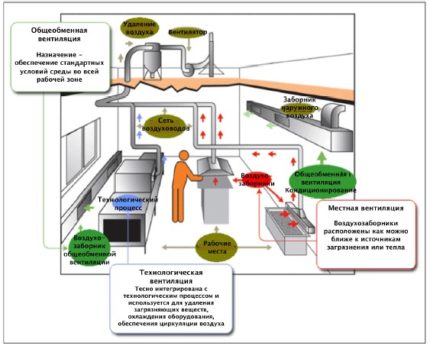
Only these two quantities are considered workers. The optimal value means that at this humidity the worker is physically comfortable working within 8 hours of a shift. Also, maintaining the optimum humidity level is a prerequisite for good performance.
The permissible value is extreme - the body of the employee of the catering unit at this humidity level can function normally without danger, harm to health. But being in a room with a maximum level of humidity can cause discomfort, adversely affect the well-being of the employee.
The indoor microclimate that does not meet SanPiN standards can cause injuries and serious physiological disturbances.
The very concept of “microclimate of the catering unit” is a collective definition, which consists of the values:
- indoor air temperature;
- surface temperature;
- humidity;
- air circulation, its speed;
- thermal radiation, its intensity.
SanPiN recommendations are aimed, inter alia, at maintaining a balance of all values of these values.
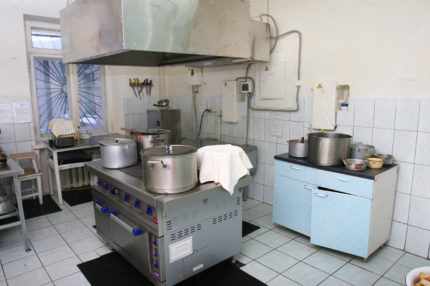
All these measures to one degree or another contribute to the maintenance of a suitable indoor microclimate.
Moisture rates in the kitchen
The special and, probably, the most important place in the catering unit can be safely called the kitchen. The process of work and working conditions of cooks are associated with the use of numerous equipment that generates heat, which negatively affects temperature and humidity.
The speed of air movement, its circulation is no less important indicator - when it meets the norm, the risk of heat stroke for the kitchen staff is reduced.
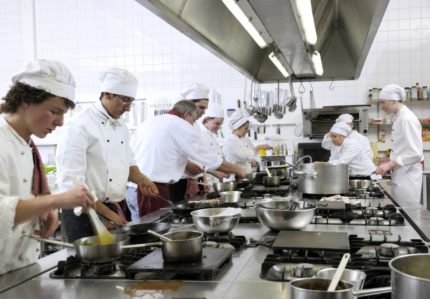
When the temperature in the kitchen is 25 ° C or more, the optimal humidity values should not exceed 70% and fall below 55%.
For different times of the year SanPiN provides certain indicators of the microclimate of the kitchen.
In the cold season, when the average daily temperature in the street is below +10, it is recommended to adhere to the following indicators in the shops:
- Meat, poultry and vegetable. The temperature in the workshop is 17-19 ° C, humidity is 40-60%, and surfaces are 16-20 ° C.
- Hot. Indoors - 17-19 ° С, humidity - 40-60%, surfaces - 16-20 ° С.
- Cold. Temperature - 19-21 ° С, humidity - 40-60%, surface temperature - 18-22 ° С.
All kitchen facilities must be equipped with ventilation systems in order to ensure the required air circulation rate.
The air speed in the kitchen in the shops, throughout the year should be at least 0.2 m / s. This is typical for all premises of the catering department, with the exception of service, linen, dressing rooms and administrative rooms. There the speed is different - 0.1 m / s.
In the warm period of time, when the average daily street temperature is from +10 ° C and above, the following testimonies are recommended on the shops:
- Meat, poultry and vegetable. Recommended 19-21 ° C at a humidity of 40-60% and with a surface temperature of 18-22 ° C.
- Hot. Stick to 19-21 ° C, relative humidity 40-60%, surface temperature - 18-22 ° C.
- Cold. Temperature 20-22 ° С, humidity - 40-60%, surface temperature 19-23 ° С.
The kitchen is not the only room in the catering complex. All rooms, halls and utility rooms are somehow connected with each other, and in all it is necessary to maintain the normal level of humidity.
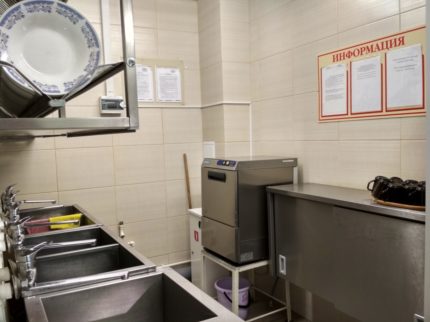
All requirements developed by Rospotrebnadzor for humidity, air temperature and surfaces prescribed in SanPiN are designed to ensure safe working conditions for the personnel working there.
The microclimate in the halls intended for eating by visitors must comply with the standards for industrial premises.
Norms of humidity in washing, washing
Equally important is the air humidity in the laundry room and in the washing rooms. Unlike the kitchen, in these rooms there is virtually no heating equipment, but a lot of water, including hot water.
This increases the level of humidity, which worsens the sanitary-hygienic situation in the catering unit. The norm in these rooms is 60-40% humidity at any time of the year.
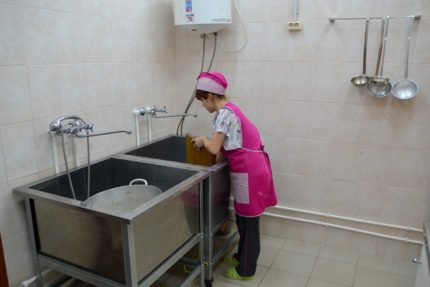
Also, to normalize humidity, the rules prescribed to carry out planned wet cleaning and surface treatment using special disinfectants strictly on schedule.
What threatens non-compliance with regulations?
Norms and rules that determine the optimal and permissible temperature and humidity are developed for a reason. Observing their values in the production room, a microclimate is maintained that is safe for the normal functioning of the human body during the working day.
Supervision of compliance with humidity standards is aimed, first of all, at the safety of life and health of employees of the catering unit, as well as at the sanitary-hygienic compliance of food products with GOST standards.
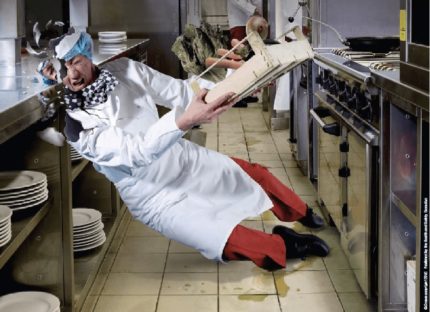
Rospotrebnadzor requires observing the temperature and humidity conditions in the catering unit, primarily in order to ensure the safety of working conditions of employees and sanitary-hygienic control of the conditions for cooking and eating.
Control and metering of humidity in the food unit
For measuring indoor humidity psychometric hygrometer, which contains two thermometers in one device - dry and wet.
By calculating the difference in readings of both thermometers using a special formula, you can get the most correct value of relative humidity.
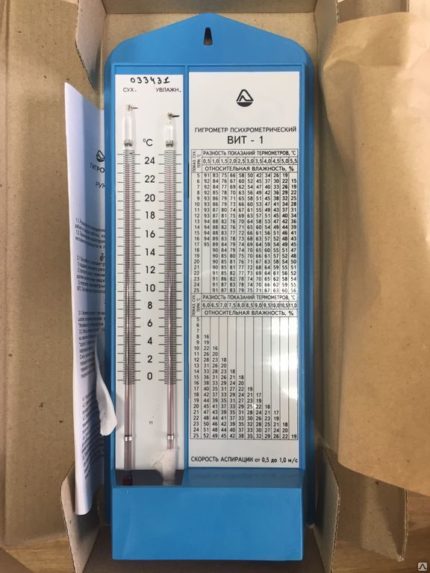
Relative humidity is measured every day, and the obtained values are mandatory recorded in the register of temperature and relative humidity and certified by the signature of the person responsible for keeping records.
Mandatory fields are the graphs of the room temperature, dry and wet thermometer values, relative humidity, and the number and time when the measurement was taken.
The journal can be kept both in electronic and in paper form.
Such scrupulousness of monitoring the temperature and humidity of the microclimate allows you to monitor compliance with the regime and timely identify deviations or trends to them.
Also, due to accounting, the person responsible for production control can timely make the necessary adjustments to improve the temperature regime - supplement the premises with system equipment ventilation and air conditioning or vice versa, working for heating.
Conclusions and useful video on the topic
Cleaning the ventilation systems in the catering unit
Diagnostics of the exhaust ventilation system in the food unit
The microclimate in the room where a person works or takes food is very important, because It has a positive effect and supports the psychophysical state of a person at the normal level. For a clear feeling of discomfort or the occurrence of health problems, a violation of any parameter that is part of the microclimate is quite enough. Therefore, the rules so clearly prescribe the balance of indicators.
If you have questions about the topic of the article, you can ask them in the box below.

 Humidity in educational institutions: legal requirements and standards
Humidity in educational institutions: legal requirements and standards 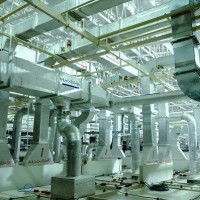 Requirements for ventilation of public buildings: subtleties of arrangement and design of ventilation
Requirements for ventilation of public buildings: subtleties of arrangement and design of ventilation  Air exchange in dentistry: norms and subtleties of arranging ventilation in a dental office
Air exchange in dentistry: norms and subtleties of arranging ventilation in a dental office 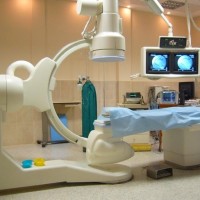 Ventilation and air conditioning for medical institutions: rules and features of the arrangement of ventilation
Ventilation and air conditioning for medical institutions: rules and features of the arrangement of ventilation  Ventilation of a room with gas-using equipment: design standards + arrangement rules
Ventilation of a room with gas-using equipment: design standards + arrangement rules 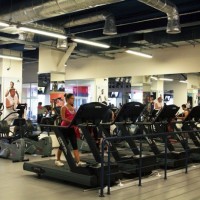 The rate of air exchange in the gym: the rules for arranging ventilation in the gym
The rate of air exchange in the gym: the rules for arranging ventilation in the gym  How much does it cost to connect gas to a private house: the price of organizing gas supply
How much does it cost to connect gas to a private house: the price of organizing gas supply  The best washing machines with dryer: model rating and customer tips
The best washing machines with dryer: model rating and customer tips  What is the color temperature of light and the nuances of choosing the temperature of the lamps to suit your needs
What is the color temperature of light and the nuances of choosing the temperature of the lamps to suit your needs  Replacement of a geyser in an apartment: replacement paperwork + basic norms and requirements
Replacement of a geyser in an apartment: replacement paperwork + basic norms and requirements